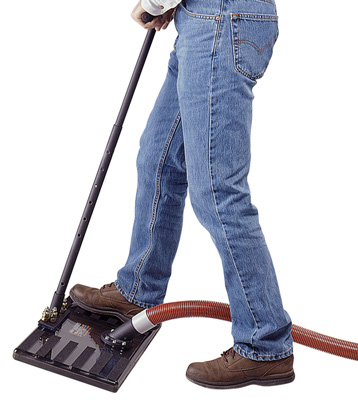Designed for quick and easy flood extraction in preparation to the final drying process.

The WATER CLAW's speed and performance in extracting most flood jobs WITHOUT removing carpet and pad has been proven in thousands of restorations worldwide.
The WATER CLAW Flood Extractor can be used to quickly evacuate water, allowing you to more easily remove and carry out carpet and pad or begin the drying process.
The specially designed bottom plate maximizes suction and water channeling into vacuum chamber. The extraction plate grid and vacuum manifold have been scientifically designed to multiply and enhance your sub-surface flood lifting capabilities in the same way a pulley system multiplies and increases weightlifting ability.
Features:
• 1/2 in. thick clear acrylic top plate for viewing extraction results.
• Vacuum release to prevent suction lock-down when stronger vacuum systems are used.
• Angled metal vacuum flange helps keep hose out of the way and accepts 1-1/2" or 2" hose cuffs.
• Upright handle adjusts to variable heights and detaches for easy storage.
• All metal parts are stainless steel, zinc coated, or powder coated.
• Polymer materials are impervious to water
• Clear acrylic top plate is highly resistant to chemical damage
How To Use the WATER CLAW Sub-Surface Flood Extractor
Speed and Efficiency will greatly increase as the operator perfects his or her rhythm in moving the WATER CLAW across the carpet.
This process is surprisingly fast and easy.
To initiate flood extraction where carpet is floating on standing water, place tool in the middle of room to draw down standing water only to face fiber level. (At this point DO NOT allow the tool to extract water from pad or face fibers.)
Water migration in pad during the succeeding Sub-Surface extraction process is essentially stopped when source water (standing water) is drawn away as described above.
Now begin the Sub-Surface extraction process in one corner. Remember to always check pad after the first few placements to confirm extraction results and adjust to appropriate tool size as needed. (See Choosing the right size WATER CLAW. )
Once the proper tool size is determined, sub-surface extraction will typically be accomplished in the first 3 to 5 seconds as the initial rush of water passes through the tool; any additional extraction time or a second pass (see Criss-Cross Method ) can be determined by the operator.
To reposition tool follow the diagrams below. Do not overlap, as this will cause the overlapped portion of the tool to suck air.
After the Sub-Surface extraction process has been performed, a small amount of water will be left on the face fibers.The operator can quickly and efficiently extract this moisture (after the Sub-Surface extraction process has been performed) with a typical wand to further reduce drying time.
After inspecting pad following a single pass of sub-surface extraction, sometimes a second pass is required. If so, the following process is recommended.
After a few passes of sub-surface extraction, inspect the pad. If a second pass is required, proceed in the following manner.
First, finish extraction of the room in one direction (i.e. north and south as illustrated in diagram A).
Next go to the original starting point and proceed cross-ways of the original path (i.e. east and west, as illustrated in diagram B).
This is called the criss-cross method and is much more effective than a second pass in the same direction or leaving in position each placement of the tool for long periods of time.
Compare to current or past OEM associations:
AC018
1699-4182
58MAC018
00802201600-9
325669126242
